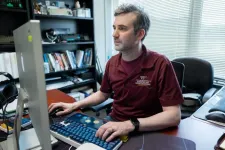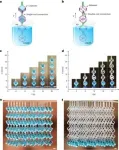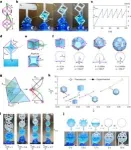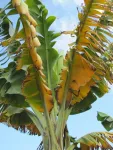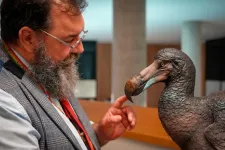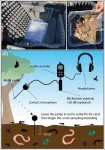(Press-News.org) On May 11, a gorgeous aurora surprised stargazers across the southern United States. That same weekend, a tractor guided by GPS missed its mark.
What do the visibility of the northern lights have in common with compromised farming equipment in the Midwest?
A uniquely powerful geomagnetic storm, according to two newly published papers co-authored by Virginia Tech's Scott England.
“The northern lights are caused by energetic, charged particles hitting our upper atmosphere, which are impacted by numerous factors in space, including the sun,” said England, associate professor in the Kevin T. Crofton Department of Aerospace and Ocean Engineering. “During solar geomagnetic storms, there’s a lot more of these energetic charged particles in the space around Earth, so we see a brightening of the northern lights and the region over which you can see them spreads out to include places like the lower 48 states that usually don’t see this display.”
England and a team of university and industry collaborators tracked the upper atmospheric event on May 11 using NASA's GOLD instrument. It turned out to be the strongest geomagnetic storm captured in the last 20 years. Their findings were recently published in Geophysical Research Letters in two studies, both co-authored by England. The first study, by first author Deepak Karan, from the University of Colorado, Boulder, showed unprecedented changes in location and spread of particles in the upper atmosphere. The second study, by first author and Virginia Tech alumnus J. Scott Evans '88, documented composition and temperature changes.
Among the collected data, England noted witnessing some "delightful swirly patterns” for the first time, and a dramatic motion of the air away from the aurora causing the formation of enormous vortices that moved air in a spiral larger than a hurricane. Specific observations included:
Unpredictable movement of low energy charged particles from around the equator toward the aurora
Charged particles that can be divided into two buckets: low energy and high energy, the latter of which can hurt humans working in space and damage electronics
Changes in temperature and pressure that likely lead to the swirls and vortices seen
Changes in locations and spread of low energy particles, which can negatively impact GPS, satellites, and even the electrical grid
“As the aurora intensifies, you see more lights, but along with that, there’s more energy entering the atmosphere, so it makes the atmosphere near the poles very hot, which starts to push air away from the poles and towards the equator,” England said. "This data poses a lot of questions like, did something really different happen during this geomagnetic storm than has happened previously, or do we just have better instruments to measure the changes?"
Furthermore, what could those changes mean for the human-made technology that orbits that region of the atmosphere?
More than a northern lights show
Earth’s upper atmosphere, spanning from about 60 to 400 miles above us, borders space and is the hang-out zone for satellites and the International Space Station. The upper atmosphere is made up of some of the same particles as the lower atmosphere, where we live and breathe. But it also has another side, the ionosphere that can be thought of almost like an electric blanket - highly charged and constantly fluctuating. These charged particles in the ionosphere are one thing that makes this region of space so dynamic. It’s common for the temperature and composition of the upper atmosphere and ionosphere to change. In fact, it does so predictably during the day and night and even changes overtime with seasons.
England said the particles in earth’s atmosphere are impacted by numerous factors in space, including the sun’s activity. During a solar geomagnetic storm flare, an intense burst of radiation from the sun changes the composition and speed of the particles within the earth’s atmosphere. So why in recent months all over the globe the northern lights have been visible in places where they’ve not been seen before now?
"The number of sunspots, flares, and storms changes with an 11-year cycle that we call the solar cycle,” England said. “The number of flares we are seeing has been increasing gradually for the last couple of years as we move toward the peak of the solar cycle."
In addition to the visibility of the northern lights, geomagnetic storms have a range of impacts on our technology. Because radio and GPS signals travel through this constantly fluctuating “electric blanket," changes in this layer of the atmosphere can disrupt signals and impede navigation and communication systems such as GPS. Various factors from both earth’s weather and space weather can impact this crucial layer, but there’s much to be learned about why changes in the upper and lower atmosphere occur and how they might impact life as we know it.
“These storms can also increase electrical currents that flow around the Earth, which can impact technological devices that use very long wires. In recent years, there have been impacts to the power grid when too much current was flowing through the wires. During the largest geomagnetic storm ever recorded, the Carrington Event in 1859, these caused telegraph systems — peak technology at that time — to catch on fire," England said.
Scientists suspect that a storm similar to the 1859 Carrington Event, if it happened today, could cause an internet apocalypse, sending large numbers of people and businesses offline. While the May 11 storm did not cause drastic disruptions, with the peak of the solar cycle expected to reach in July 2025, we are still about a year away from knowing those potential effects.
“One reason we study geomagnetic storms is to try and build models to predict their impacts,” England said. “Based on the solar cycle, we’d expect the conditions we’re seeing this year to be around for about the next two years.”
END
New research shows unprecedented atmospheric changes during May's geomagnetic superstorm
What could the anomalies in temperature, composition, location, and spread of particles mean for satellites and GPS?
2024-08-16
ELSE PRESS RELEASES FROM THIS DATE:
How some states help residents avoid costly debt during hard times
2024-08-16
COLUMBUS, Ohio – A new national study provides the best evidence to date that generous unemployment insurance benefits during the COVID-19 pandemic helped reduce reliance on high-cost credit use.
Researchers found that lower-income residents of states with more generous benefits were significantly less likely than those living in less-generous states to take out new credit cards, personal finance loans and payday loans or other alternative financial service offerings.
The study, published recently in the journal ...
Same person. Different place. Twice the odds of a dementia diagnosis.
2024-08-16
With new medications on the market or in the works for Alzheimer’s disease and other kinds of dementia, a new study suggests that getting the diagnosis needed to access these new treatments may depend on where you live.
The percentage of people who get a new dementia diagnosis each year varies a lot across regions of the U.S., the study finds.
And the differences between regions of the country are even larger for people on the young end of the dementia-risk age range, ages 66 to 74, and for those who are Black ...
The banana apocalypse is near, but UMass Amherst biologists might have found a key to their survival
2024-08-16
August 16, 2024
The Banana Apocalypse is Near, but UMass Amherst Biologists Might Have Found a Key to Their Survival
Discovery of molecular mechanisms used by the banana-destroying microbe brings hope to the breakfast table
AMHERST, Mass. – The bananas in your supermarket and that you eat for breakfast are facing functional extinction due to the disease Fusarium wilt of banana (FWB) caused by a fungal pathogen called Fusarium oxysporum f.sp. cubense (Foc) tropical race 4 (TR4). However, thanks to recent research from an ...
Rethinking the dodo
2024-08-16
Rethinking the Dodo
Review of 400 years of scientific literature corrects the record on icon of extinction
Researchers are setting out to challenge our misconceptions about the Dodo, one of the most well-known but poorly understood species of bird.
In a paper published today [16 August 2024] in the Zoological Journal of the Linnean Society researchers from the University of Southampton, Natural History Museum (NHM) and Oxford University Museum of Natural History have undertaken the most comprehensive review of the taxonomy of the Dodo and its closest relative, the Rodriguez ...
Arts and crafts improves your mental health as much as having a job, scientists find
2024-08-16
Could arts and crafts help protect the public’s mental health? A new study in Frontiers in Public Health provides evidence that indulging our creative side could provide everyone with a significant wellbeing boost. Because arts and crafts are relatively affordable and accessible, promoting the public’s access to artistic activities could provide a major boost to public mental health.
“Crafting and other artistic activities showed a meaningful effect in predicting people’s ...
It’s a rave – underground acoustics amplify soil health
2024-08-16
Barely audible to human ears, healthy soils produce a cacophony of sounds in many forms – a bit like an underground rave concert of bubble pops and clicks.
Special recordings made by Flinders University ecologists in Australia show this chaotic mixture of soundscapes can be a measure of the diversity of tiny living animals in the soil, which create sounds as they move and interact with their environment.
With 75% of the world’s soils degraded, the future of the teeming community of living species that live underground face a dire future without restoration, says microbial ecologist Dr Jake Robinson, from the Frontiers ...
New poll finds 50% of parents believe too much time on technology hinders kids from forming connections in the classroom
2024-08-16
COLUMBUS, Ohio (August 16, 2024) – Building positive connections with teachers and peers in the classroom can be critical to the mental health and academic success of children and adolescents. Yet, a new national poll from The Kids Mental Health Foundation, conducted by Ipsos, finds half of parents believe spending too much time on technology and social media hinder children from making meaningful connections as they head into the upcoming school year.
The poll, conducted by Ipsos on behalf of ...
How policing impacts the homeless
2024-08-16
People who are homeless often endure constant and intrusive police interactions, leaving them feeling intimidated, harassed and stigmatised, a new study finds.
More people of all ages and backgrounds are finding themselves homeless, often due to job loss or illness, as well as a lack of affordable housing. Between 2016 and 2021 homelessness increased by 5.2% in Australia.
Professor of Law Thalia Anthony from the University of Technology Sydney (UTS) said the research aimed to give a voice to people experiencing homelessness ...
Scottish and Irish rocks confirmed as rare record of ‘snowball Earth’
2024-08-16
A rock formation spanning Ireland and Scotland may be the world’s most complete record of “snowball Earth”, a crucial moment in planetary history when the globe was covered in ice, finds a new study led by UCL (University College London) researchers.
The study, published in the Journal of the Geological Society of London, found that the Port Askaig Formation, composed of layers of rock up to 1.1km thick, was likely laid down between 662 to 720 million years ago during the Sturtian glaciation – the first of two global freezes thought to have ...
Research provides a roadmap for improving electrochemical performance
2024-08-16
Thomas Edison went through thousands of materials before he finally found the right tungsten filament to create a working lightbulb. This type of trial-and-error research continues today and is responsible for countless inventions that improve our world. Battery systems that help power our lives in many seen (and unseen) ways are one example.
However, improving these materials and devices requires more than experimentation. Modern engineers must also form a deeper understanding of the general principles that govern material performance, from which they can design better materials to achieve challenging product requirements.
In a paper ...
LAST 30 PRESS RELEASES:
Injectable breast ‘implant’ offers alternative to traditional surgeries
Neuroscientists devise formulas to measure multilingualism
New prostate cancer trial seeks to reduce toxicity without sacrificing efficacy
Geometry shapes life
A CRISPR screen reveals many previously unrecognized genes required for brain development and a new neurodevelopmental disorder
Hot flush treatment has anti-breast cancer activity, study finds
Securing AI systems against growing cybersecurity threats
Longest observation of an active solar region
Why nail-biting, procrastination and other self-sabotaging behaviors are rooted in survival instincts
Regional variations in mechanical properties of porcine leptomeninges
Artificial empathy in therapy and healthcare: advancements in interpersonal interaction technologies
Why some brains switch gears more efficiently than others
UVA’s Jundong Li wins ICDM’S 2025 Tao Li Award for data mining, machine learning
UVA’s low-power, high-performance computer power player Mircea Stan earns National Academy of Inventors fellowship
Not playing by the rules: USU researcher explores filamentous algae dynamics in rivers
Do our body clocks influence our risk of dementia?
Anthropologists offer new evidence of bipedalism in long-debated fossil discovery
Safer receipt paper from wood
Dosage-sensitive genes suggest no whole-genome duplications in ancestral angiosperm
First ancient human herpesvirus genomes document their deep history with humans
Why Some Bacteria Survive Antibiotics and How to Stop Them - New study reveals that bacteria can survive antibiotic treatment through two fundamentally different “shutdown modes”
UCLA study links scar healing to dangerous placenta condition
CHANGE-seq-BE finds off-target changes in the genome from base editors
The Journal of Nuclear Medicine Ahead-of-Print Tip Sheet: January 2, 2026
Delayed or absent first dose of measles, mumps, and rubella vaccination
Trends in US preterm birth rates by household income and race and ethnicity
Study identifies potential biomarker linked to progression and brain inflammation in multiple sclerosis
Many mothers in Norway do not show up for postnatal check-ups
Researchers want to find out why quick clay is so unstable
Superradiant spins show teamwork at the quantum scale
[Press-News.org] New research shows unprecedented atmospheric changes during May's geomagnetic superstormWhat could the anomalies in temperature, composition, location, and spread of particles mean for satellites and GPS?
